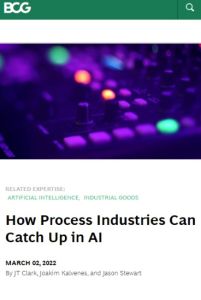Join getAbstract to access the summary!

Join getAbstract to access the summary!
JT Clark, Joakim Kalvenes and Jason Stewart
How Process Industries Can Catch Up in AI
Boston Consulting Group, 2022
What's inside?
What’s your company’s excuse for failing to fully adopt AI?
Recommendation
There was a time you could dismiss AI as being experimental, or overly techy for the physical industries of mining, chemical manufacturing, and oil and gas. That time is over. One look at the value AI has unlocked in other industries is all the proof your company should need to give artificial intelligence a chance. This Boston Consulting Group article provides solutions for overcoming some of the most daunting hurdles to AI, along with a brief overview of the benefits your company can expect from applying AI advantages to your industry.
Summary
About the Authors
JT Clark, Joakim Kalvenes and Jason Stewart are professionals located in the Calgary, Chicago and Los Angeles offices of the Boston Consulting Group.


















Comment on this summary